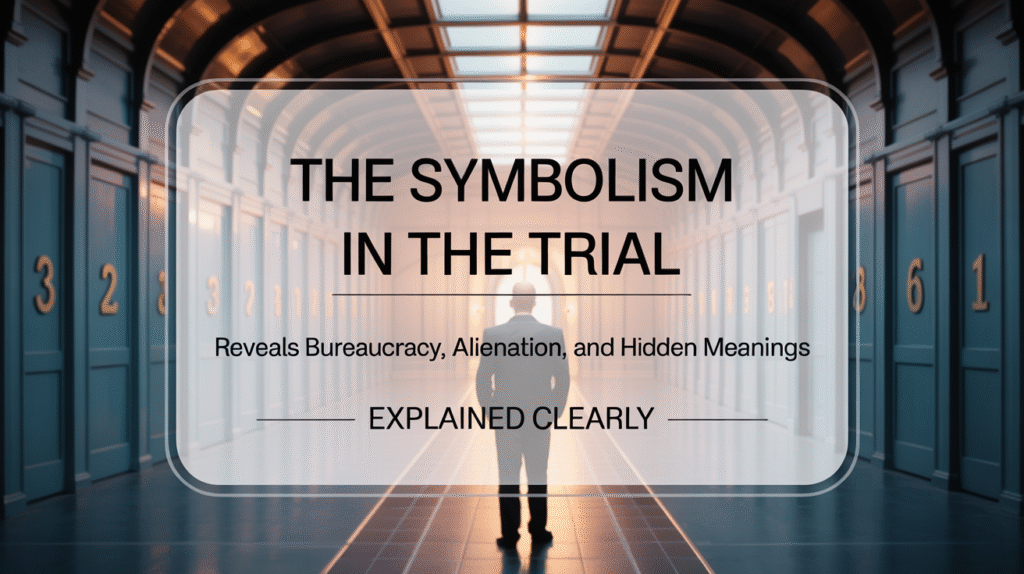The symbolism in Franz Kafka’s The Trial is the key to understanding its unsettling atmosphere and lasting power. Doors, documents, labyrinthine spaces, and the parable “Before the Law” are not just details—they are symbols of authority, alienation, and the absurdity of guilt without crime. By unpacking these hidden meanings, readers can see how Kafka transformed an ordinary story of arrest into a universal allegory of modern existence.

Doors and Thresholds as Symbols of Exclusion
Doors in The Trial represent barriers to knowledge, justice, and freedom.
Denial of access
K. repeatedly encounters doors that are locked, guarded, or lead only to more hallways.
- Doors stand for the court’s control over who may enter and who is excluded.
- The uncertainty of what lies beyond mirrors K.’s inability to access justice.
Symbolic thresholds
Crossing a door often signals transition into another layer of the bureaucracy.
- Every threshold promises access but delivers confusion.
- The famous parable “Before the Law” reinforces the idea that entry is always deferred.
Documents, Files, and Paperwork as Symbols of Authority
Kafka shows how paper and ink acquire more power than human judgment.
Paper replaces truth
Official documents in the novel often have unclear content, yet their existence is treated as unquestionable.
- Files stand for institutional legitimacy.
- Stamps and seals transform blank pages into instruments of power.
Endless paperwork
The proliferation of forms symbolises how process becomes more important than outcomes.
- K.’s case is drowned in layers of meaningless bureaucracy.
- Paper becomes the weapon that sustains guilt without resolution.
Labyrinths, Attics, and Claustrophobic Spaces
The architecture of The Trial symbolises disorientation and suffocation.
Labyrinthine structures
Courtrooms are hidden in attics and corridors twist into endless confusion.
- The physical maze reflects the mental maze of dealing with bureaucracy.
- Disorientation is itself a form of control.
Stale, airless interiors
Rooms are often crowded, overheated, or oppressive.
- Airless spaces symbolise the suffocation of individuality.
- Physical discomfort mirrors the crushing weight of institutional power.
Surveillance and Watching Eyes
Kafka’s world is filled with witnesses, informants, and eyes that never close.
Society as the court
Neighbours, landlords, and colleagues often seem complicit with officials.
- Surveillance spreads beyond the courtroom into daily life.
- Everyone becomes a participant in K.’s humiliation.
Internalised surveillance
K. begins to act as if he is always being watched, symbolising how power becomes self‑perpetuating.
- Shame operates even without a visible audience.
- The gaze of others becomes embedded in K.’s own conscience.
Women as Ambiguous Symbols
Female characters in The Trial often appear as both helpers and obstacles, reflecting the entanglement of desire and authority.
Sexuality as exchange
Many women in the novel are linked to officials or offer aid only through intimacy.
- Relationships symbolise compromise rather than liberation.
- Intimacy becomes another channel for control.
Ambiguity of roles
Women are never straightforward allies or enemies.
- Their shifting roles reflect the instability of meaning itself.
- They highlight how even personal connections are absorbed into the system.
The Parable “Before the Law”
This embedded story is the novel’s most powerful symbolic passage.
The man before the gate
A man waits his entire life to gain access to the Law, but the doorkeeper never lets him through.
- The gate symbolises justice or ultimate truth.
- Waiting itself becomes the punishment.
Universality of exclusion
The parable implies that the Law is never directly accessible, only mediated by endless thresholds.
- The story mirrors K.’s own futile quest.
- It also symbolises humanity’s perpetual longing for meaning.
Execution “Like a Dog”
The novel ends with K.’s death in a quarry, where he cries, “Like a dog!”
Symbol of humiliation
The comparison to a dog reflects loss of dignity and identity.
- Death is not the worst punishment—shame is.
- Being treated as less than human symbolises the dehumanising power of institutions.
Shame outlives death
Kafka suggests that humiliation is more enduring than physical punishment.
- K.’s cry is a recognition of his complete degradation.
- It is also a warning about how systems of power break people spiritually as well as physically.
Why Symbolism Matters in The Trial
Kafka uses symbols to communicate universal truths about guilt, power, and alienation.
Universal relevance
By avoiding concrete details, symbols allow the novel to transcend its time and setting.
- Any reader, in any society, can see their own bureaucracies reflected.
- The symbols keep the novel alive in modern contexts such as surveillance states and algorithmic systems.
Emotional resonance
Symbols make the abstract feel concrete.
- Doors, files, and staircases turn anxiety into lived experience.
- Readers feel K.’s suffocation because the imagery makes it tangible.
FAQs: Symbolism and Hidden Meanings in The Trial
Here are some questions and answers about the symbolism in Franz Kafka’s The Trial.
What do doors symbolise in The Trial?
Doors symbolise exclusion and deferred access. They promise entry but deliver only more waiting, reflecting K.’s inability to ever reach the truth or justice.
Why is paperwork so important in the novel?
Paperwork symbolises bureaucratic authority. Files, forms, and stamps carry more weight than truth itself, turning documents into instruments of control.
What is the meaning of the parable “Before the Law”?
It symbolises humanity’s endless waiting for justice or ultimate truth. The man’s lifelong delay reflects the futility of accessing authority directly, just as K. never reaches resolution in his case.
Why does Kafka end the novel with “Like a dog”?
The phrase symbolises humiliation. Kafka highlights that shame, not death, is the final punishment. K. recognises his degradation as he dies.
How does space and architecture function symbolically in The Trial?
Claustrophobic interiors and labyrinthine layouts symbolise the disorientation and suffocation of living under a faceless system. The oppressive spaces mirror K.’s psychological state.
Key takeaway: The symbolism in The Trial—from doors and documents to labyrinths and shame—reveals how Kafka transforms bureaucracy into a metaphor for human existence. By reading these symbols closely, we understand why the novel remains one of the most haunting allegories of modern life.
